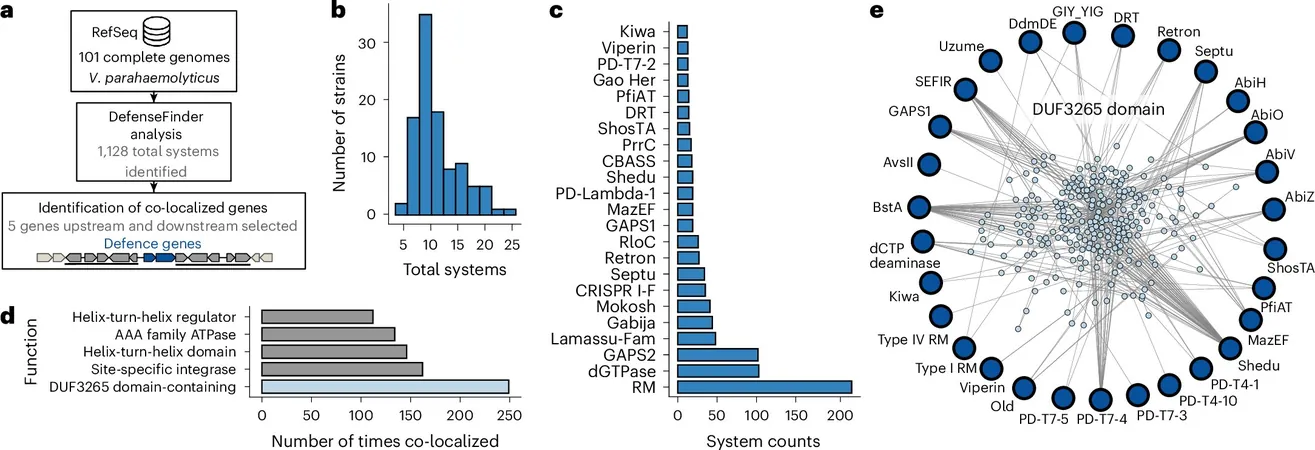
Revolutionary Discovery: Nine Genes Could Transform Phage Therapy in the Fight Against Drug-Resistant Bacteria!
2025-03-19
Author: Yu
Introduction
In an exciting breakthrough, researchers at the University of Toronto have identified nine novel genes that allow bacteria to defend themselves against phages—viruses that specifically target bacteria. This research, published in the esteemed journal *Nature Microbiology*, could pave the way for innovative treatments for bacterial infections, especially those that are resistant to traditional antibiotics.
Research Methodology
Using a blend of bioinformatics tools and practical laboratory experiments, the research team examined sediment samples from tanks at Ripley's Aquarium of Canada. This unusual setting has allowed them to uncover critical information on bacterial defense mechanisms against phage attacks.
Understanding Bacterial Defense
"Phages naturally prey on bacteria," affirms Landon Getz, the study's lead author and a post-doctoral researcher in Professor Karen Maxwell's biochemistry lab. "By comprehending how bacteria activate their defense measures against these viruses, we can devise strategies to circumvent these defenses."
Focus on *Vibrio parahaemolyticus*
The specific bacterium they focused on is *Vibrio parahaemolyticus*, notorious for causing gastroenteritis in humans through the consumption of contaminated seafood. The research delved into the bacterial genome's integron—a region rich with acquired genes that enhance the bacteria's survival odds, including antibiotic resistance and, as discovered, defenses against phage infection.
Hypothesis and Gene Exploration
"Genes related to anti-phage defenses are often grouped together in bacterial genomes," explains Getz, who is also a GSK EPIC Convergence Postdoctoral Fellow specializing in Antimicrobial Resistance. Their hypothesis was that the integron might hide unknown genes that contribute to anti-phage strategies.
Experimental Approach
To explore this, the researchers employed bioinformatics to sift through 57 genes within the *Vibrio* integron and mapped over 70 phages to test the efficacy of these potential defense systems against viral infections. Given the limited known phages that infect *V. parahaemolyticus*, the researchers had to look beyond traditional sources, utilizing sediment samples from the aquarium, which housed jellyfish and sea dragons.
Phage Spotting Technique
Employing a technique called phage spotting, the team inserted the 57 genes into different strains of bacteria growing on agar plates. They introduced various phage samples to these plates to observe whether the bacteria could withstand viral attacks.
Results and Findings
"The presence of clear zones on the plates indicates a failure to defend against the phage, inhibiting bacterial growth," said Sam Fairburn, a co-author and undergraduate student who gained valuable experience as a co-op student in the Maxwell lab. Through their diligent experiments, the team identified nine unique defense genes hitherto unknown.
Energy Consumption and Activation
Interestingly, while these genes bolster the bacteria's ability to survive attacks, their activation consumes substantial energy. Therefore, bacteria instinctively turn on these defenses only when encountering certain environmental signals. The researchers uncovered that four of the nine genes showed heightened activation in response to quorum sensing—an ability of bacteria to communicate and respond to population density.
Conclusion and Implications
"As viral attacks escalate when bacteria are numerous, it's logical that these defenses would be activated in social interactions among bacterial communities," notes Getz, who collaborates with Mikko Taipale, an associate professor of molecular genetics.
The implications of this research extend beyond *Vibrio* species. Integrons are prevalent across roughly 10% of all bacterial genomes, which positions them as new key targets in phage therapy development. By enhancing our understanding of bacterial defenses against phage attacks, this discovery could lead to more effective treatments for bacterial infections in an era plagued by rising antibiotic resistance.
Future Research
Stay tuned as we continue to track this groundbreaking research that could redefine our approach to fighting superbugs!



 Brasil (PT)
Brasil (PT)
 Canada (EN)
Canada (EN)
 Chile (ES)
Chile (ES)
 Česko (CS)
Česko (CS)
 대한민국 (KO)
대한민국 (KO)
 España (ES)
España (ES)
 France (FR)
France (FR)
 Hong Kong (EN)
Hong Kong (EN)
 Italia (IT)
Italia (IT)
 日本 (JA)
日本 (JA)
 Magyarország (HU)
Magyarország (HU)
 Norge (NO)
Norge (NO)
 Polska (PL)
Polska (PL)
 Schweiz (DE)
Schweiz (DE)
 Singapore (EN)
Singapore (EN)
 Sverige (SV)
Sverige (SV)
 Suomi (FI)
Suomi (FI)
 Türkiye (TR)
Türkiye (TR)
 الإمارات العربية المتحدة (AR)
الإمارات العربية المتحدة (AR)